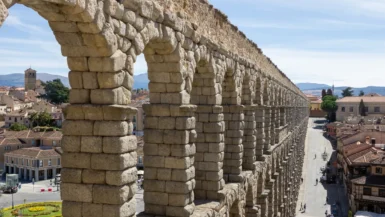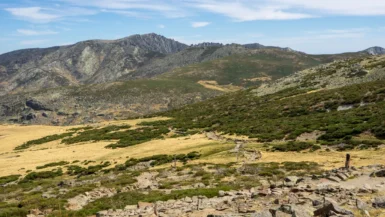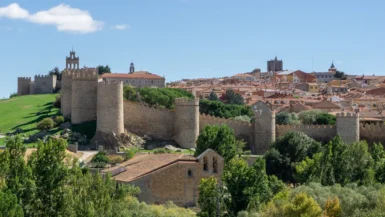Are you hiking the famous Camino de Santiago and do you want to know what to pack? Check this packing list for the Camino de Santiago now!
Hikin the Camino de Santiago
The Camino de Santiago, also known as the pilgrimage route to Santiago de Compostela, attracts thousands of adventurers from all over the world every year. Whether you’re going for spiritual enlightenment, personal growth, or just a physical challenge, it’s important to go out prepared. An essential part of that preparation is putting together your Camino packing list.
Packing list for the Camino de Santiago
In this blog post, you’ll read about what to bring in any case and how it can vary by season. Let’s start with the essential items.
Start with the right backpack
A good backpack is crucial during your adventure on the Camino. Choose a comfortable model with enough room for all your necessities, but again, the backpack should not be too big.
The size of a backpack is always measured in liters, for hiking the Camino I would go for a 30 to 45 liter backpack. Rather not larger, because then you automatically take more with you, and your backpack will be lot heavier.
I myself carried a 30 liter backpack from Gregory during my hike on the Camino del Norte and it was perfect. You can stuff a lot more in it than you might think!

Also, consider purchasing a rain cover to keep your gear dry during unexpected rainstorms. Alternatively, you can put a garbage bag or lightweight dry bag in your bag to keep your belongings dry.
Hiking boots
Good hiking boots are, of course, also a must for a long-distance hike. During my hikes, I have found that this is very personal to each person. For example, I myself prefer to hike on lightweight trail runners (the Hoka Speedgoat), they are incredibly comfortable and they dry quickly when wet. Other people prefer to walk on mountain boots.
Either way, make sure you’ve walked on them a few times before starting your trek, then you’ll know if they’re comfortable. Especially sturdy mountain boots you really need to run in to avoid blisters.
Besides the shoes you hike with every day, it’s also nice to bring an extra pair (lightweight) for evenings. These can also be slippers or sandals, these are also useful for communal showers to prevent foot fungus.
Hiking socks
Good hiking socks are something I never considered necessary, but now I think they’re very important. It makes so much difference! And yes, they are expensive, but you also use them for a very long time. Also, if you purchase socks with merino wool, they are a lot less likely to smell, so you can put them back on more often.
I usually bring two pairs of good hiking socks for a long hike, then I can alternate them. My favorite brands are Smartwool and Falke.
Clothing
Choose clothing suitable for different weather conditions, depending on the season in which you run. Think breathable shirts and pants for warmer days, as well as warm layers and rain gear for colder and wetter days. Clothing made of merino wool is ideal; this is lightweight, warm, and doesn’t stink easily.
Don’t forget to also bring comfortable sleepwear and swimwear for nights in hostels with shared facilities or while swimming in the sea.
Quick-drying towel
All hostels allow you to wash or shower, but towels are rarely provided. It is therefore convenient to bring a quick-drying towel. I myself carried a pareo in addition to a microfiber towel. This one is incredibly lightweight and you can also use it as a scarf, towel, or blanket.
Sleeping bag
Because the inns you sleep in rarely have bedding, a lightweight, compact sleeping bag is a must-have item for any pilgrim. Make sure your sleeping bag is appropriate for the temperature in which you will be hiking. In summer, you will probably have enough with a thin sleeping bag liner, while a thicker sleeping bag may be necessary in colder months.

Toiletries
Bring only essential toiletries, such as toothpaste, toothbrush, soap, shampoo, and sunscreen. Remember to use small travel packs to save space in your backpack.
For ladies, it is also helpful to bring a few tampons or pads. Personally, I prefer to use a menstrual cup, as you don’t have to change it as often and you can easily clean it. But it’s up to you what you feel most comfortable with.
First aid kit
A small first aid kit should not be missing from your packing list. Make sure it contains: band-aids, disinfectant, painkillers, blister plasters, and any other medications you may need during the trek.
Documents
Always keep important documents such as your passport, identity card, insurance papers, and pilgrim’s passport in a safe (preferably waterproof) place in your backpack. You can get the pilgrim passport (credencial) in churches or albergues along the trail.

Refillable Water Bottle
Of course, you cannot do without a water bottle and you can refill it in many places. I recommend (especially in the hot summer months) carrying at least 2 liters of capacity, such as two 1-liter bottles.
You can also bring a water bag and put it in the back of your backpack, but personally, I’m not a fan of that because it’s very hard to clean.
Earplugs & sleep mask
If you sleep in the hostels among the other pilgrims, earplugs and a sleeping mask are almost essential, unless you are a very deep sleeper. There is always someone snoring and there is always someone turning on a lamp in the early morning when it is still dark. With earplugs and a mask, you can shut yourself off better and the chances of getting a good night’s sleep are much better.
Other supplies
Those were the absolute must-haves for your Camino packing list. Other items that may come in handy are:
- Sunglasses
- Sun hat
- Duct tape for minor repairs
- A small pocket knife
- Chargers for your electronics
- A headlamp, for when you occasionally walk in the dark. Choose a headlamp with a red light function, which is nicer for your fellow pilgrims when you turn it on at the hostel.
- Cash, as many places don’t accept card payments.
- Trekking poles. While not necessarily necessary, it can be very nice for added stability.
- A hiking guide. The Camino is generally very well marked, but sometimes it can be helpful to have a description on paper as well. Then you know what to expect, even in terms of highest and difficulty.
- E-reader. This is of course very personal, but I love to take a break during a long hiking day and enjoy a nice book.
- Diary. Walking the Camino is an experience you will never forget. It can be nice to write down your feelings and thoughts during the trip.
It is important to listen to your body and take what you need. The Camino is a long trek, so it is important to take good care of yourself.
What you absolutely must not take with you on the Camino de Santiago
It is very easy to take too much with you on the Camino. And I know that you’d rather not, because then your bag gets very heavy very quickly. Therefore, I am now sharing a list of the things it is better to leave at home when walking the Camino.
Superfluous clothing
- Heavy, cotton clothing: Cotton absorbs moisture and dries slowly, which can cause chafing. Choose lightweight, synthetic clothing that is quick-drying.
- Redundant shoes: Bring at most two pairs of shoes: a pair of sturdy hiking boots and a pair of lighter shoes (or slippers/sandals) for evenings. Avoid new shoes, wear them in before you go out.
- Jeans: Jeans are heavy and uncomfortable to walk in. Choose lighter pants made of cotton or stretch.
- Coats and sweaters: Bring a raincoat and a fleece for colder days, but leave heavy coats and sweaters at home. Layering is the code word.
- Clothes for special occasions: You’re out for a long trip; it’s not a fashion show. Bring only clothes that you are comfortable to walk in.
Superfluous toiletries
- Large bottles of shampoo and shower gel: Opt for small travel packs or buy them on the go.
- Hair dryer and straightener: Unnecessary luxury that adds a lot of weight.
- Make up: Bring only some basic products if you want, you won’t have time to do extensive makeup (and it melts right off after a short climb).
Other
- Heavy backpack: Choose a lightweight backpack that is comfortable and fits your height.
- Valuable items: Leave expensive jewelry and large electronics at home. Bring only what you really need.
- Heavy books: Choose e-books or audiobooks to save weight.
- Excess snacks: You can buy food in the villages and towns along the route. Just bring some snacks for the road.
A few additional tips for your Camino Packing List
- Be critical: Think carefully about whether you really need each item.
- Keep it light: Try to keep your backpack under 10 kilos (22 pounds).
- Buy what you need along the way: You can always buy stuff in the villages and towns along the route.
It is important to remember that you want to travel as lightly as possible on the Camino de Santiago. Consider each item critically before adding it to your packing list. Avoid unnecessary luxuries and bring only essential items you need during the trip.
Hiking in summer vs. winter
In addition, it is good to know that the contents of your packing list may vary depending on the season in which you will be hiking. In the summer months, for example, you need lighter clothing and can probably suffice without a sleeping bag or with a thin sheet bag. In the winter months, on the other hand, you should bring extra warm clothes and a thick sleeping bag to withstand the cold temperatures.
In short, compiling a Camino packing list is crucial to a successful pilgrimage. Make sure you have the right backpack, wear comfortable hiking shoes, and bring essential items such as clothing, toiletries, first aid kit, documents, and other necessities.
If necessary, adjust your packing list based on the season in which you will be hiking. With a well-equipped backpack, you are ready to take this unforgettable journey to Santiago de Compostela. Buen Camino!
Read more about the Camino de Santiago
Looking for more Camino tips or want to read experience stories? These are some fine books about the Camino.
Camino de Santiago – Camino Francés: Guide With Map Book
Moon Camino de Santiago: Sacred Sites, Historic Villages, Local Food & Wine
I have walked several sections of the Camino in recent years, so you can find more tips for the Camino and other beautiful hikes in Europe on this website. Check out these articles for more tips:
- 16 Best Books on Camino de Santiago
- Hiking the Camino del Norte | The Ultimate Guide
- Hiking in Galicia Spain: 10 incredible trails
Sign up for my newsletter for great travel stories, travel inspiration and tips on the special destinations.
Hi, and how nice of you to read this disclaimer! As you may understand, maintaining a website costs money. Therefore, I would love it if you use the links in this article for booking or buying something you like. This way I get a small commission which I can use to maintain this website. At no additional cost to you. Thanks! Support Travel with Co.





Leave a reply